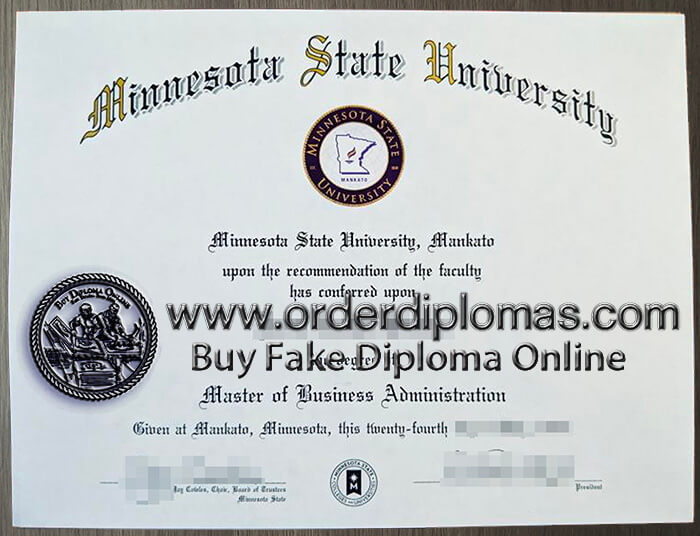
buy fake minnesota state university degree
Buy fake minnesota state university diploma, buy fake minnesota state university degree, buy fake minnesota state university certificate, buy fake diploma, buy fake degree, buy fake certificate, make fake diploma, order fake diploma, fake degree, buy fake diploma online, buy fake diploma in USA.
Minnesota State University, Mankato (MSU or MNSU), also known as Minnesota State, is a public university in Mankato, Minnesota. Established as the Second State Normal School in 1858, it was designated in Mankato in 1866, and officially opened as Mankato Normal School in 1868. It is the second oldest member of the Minnesota State Colleges and Universities system. It is also the second largest university in the state, and has over 123,000 living alumni worldwide. It is the most comprehensive of the seven state universities and is referred to as the flagship of the Minnesota State Colleges and Universities system. It is an important part of the economy of Southern Minnesota and the state, as it adds more than $781 million to the economy of Minnesota annually.
Minnesota State offers 130 undergraduate programs of study, 75 graduate programs and 4 doctoral programs. It hosts the only nationally, regionally, and state accredited aviation program in Minnesota. Students are served by 750 full-time faculty members, creating a 21:1 student to faculty ratio. In addition to the main campus, it operates two satellite campuses: one in the Twin Cities suburb of Edina and the other in Owatonna. Through the College of Extended Learning it provides bachelor’s degrees at the Normandale Partnership Center in Bloomington and programs online through an online campus.
State Teachers College
By 1921, the school had grown significantly to the point that it began to offer four-year bachelor’s degrees. As a result, it was renamed the Mankato State Teachers College. The original Old Main building was destroyed in a fire in 1922 and a new building was completed on April 4, 1924. Enrollment then dipped during World War II and the college refocused its extension programs on providing education to members of the Works Progress Administration and Naval Corps.
Rapid post-World War II expansion
During the post-World War II period, student enrollment expanded greatly. The original university buildings were then located in what was known as the Valley Campus. It was located geographically down the hill in lower Mankato. The size and footprint of the Valley Campus could not sustain the space needed to handle the growing student body. The Mankato Teachers College received 12 former Army barracks as a short-term solution. By the late 1950s work began on constructing an entirely new, modern campus atop the river valley bluff. This became the Highland Campus. A new experimental school called the Wilson School was built on the Highland Campus to research and apply new teaching methods for students in grades K-12. The intent of this school was to provide student teachers the opportunity to learn and experiment with new methods in a university environment.
Transition to comprehensive university
By 1957, the mission of the institution had broadened to comprehensive four-year college education, the state legislature changed the name of the college to Mankato State College. The following years saw additional enrollment growth. By the 1960s the institution had grown so fast and so large that there was a bill created in the State Legislature to designate it the University of Southern Minnesota by state Senator Val Imm and later an amendment to the bill by state Representative Mike McGuire would have renamed it Minnesota State University. These were proposed long before the popular television show Coach aired. It was proposed to be a second and independent state university equal in stature to the University of Minnesota at a time when there was only one research institution. There was significant opposition from the University of Minnesota and from Governor Karl Rolvaag at the time.
In 1975, the college successfully made the case to transition to comprehensive status and was renamed to Mankato State University. This change reflected a further 40% growth in the student body to 12,000 students by 1972. Following this period was a movement toward increasing the number of available programs including science, technology, engineering, health sciences and others. The university became more comprehensive in its programmatic offerings. While the transition to “state university” was being considered, administration also explored the prospect of combining the “Valley Campus” buildings with the “Highland Campus” on recommendation of a consultant hired by the Higher Education Coordinating Commission. Despite some faculty opposition to the merger, Mankato State University received permission to consolidate in May 1977 and completed the consolidation under President Margaret Preska on May 5, 1980. The Valley Campus was eventually sold to a private developer and the Highland Campus grew in size.

 USA Diplomas
USA Diplomas Canada Diplomas
Canada Diplomas UK Diplomas
UK Diplomas Australia Diplomas
Australia Diplomas Germany Diplomas
Germany Diplomas Malaysia Diplomas
Malaysia Diplomas Singapore Diplomas
Singapore Diplomas Other countries
Other countries Transcript-Form.xlsx
Transcript-Form.xlsx
